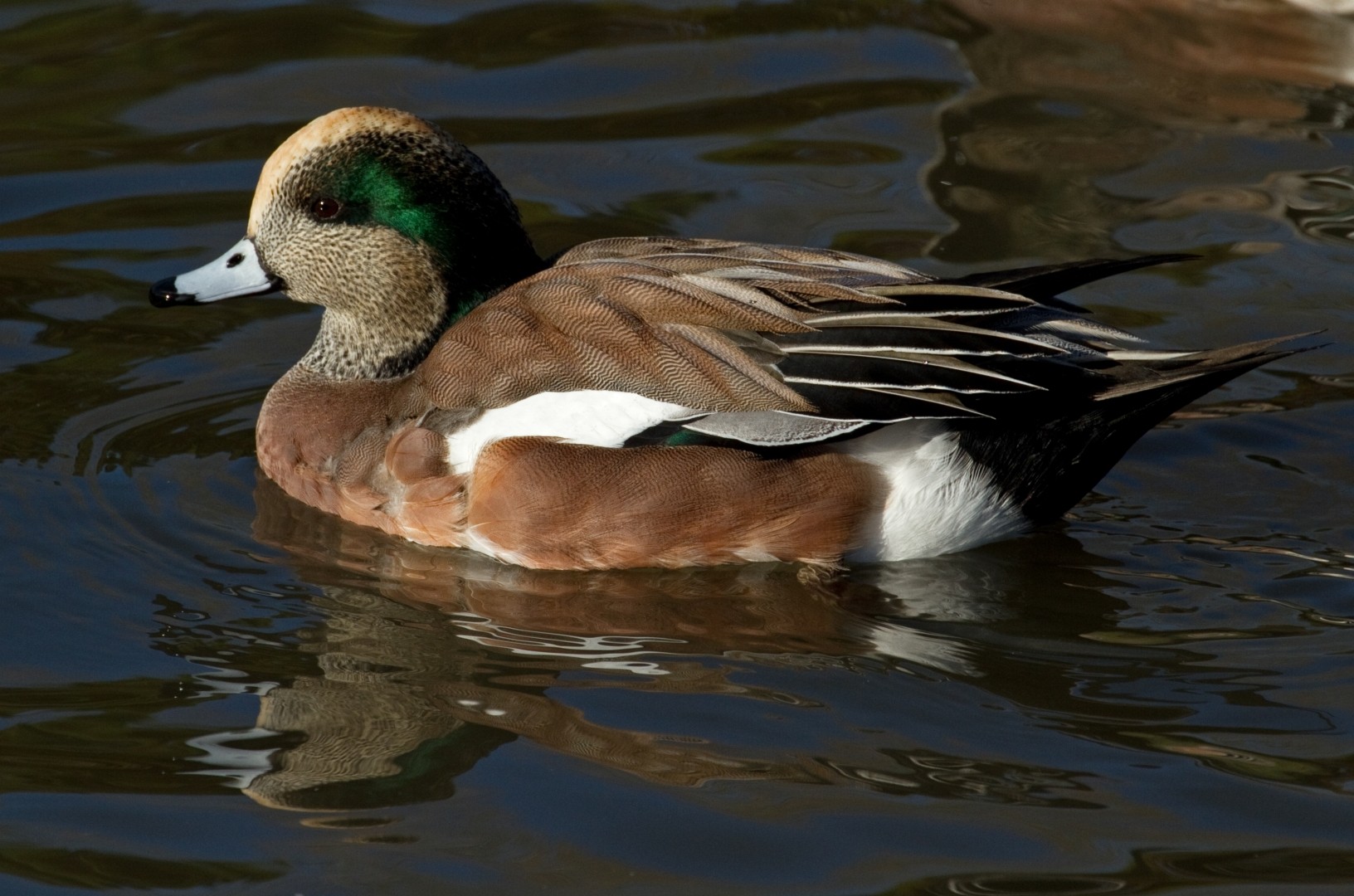American Wigeon
A species of Anas Scientific name : Mareca americana Genus : Anas
American Wigeon, A species of Anas
Botanical name: Mareca americana
Genus: Anas
Content
Description General Info
Description
The American wigeon is a medium-sized bird; it is larger than a teal, but smaller than a pintail. In silhouette, the wigeon can be distinguished from other dabblers by its round head, short neck, and small bill. It is 42–59 cm (17–23 in) long, with a 76–91 cm (30–36 in) wingspan and a weight of 512–1,330 g (1.129–2.932 lb). This wigeon has two adult molts per year and a juvenile molt in the first year, as well. The breeding male (drake) is a striking bird with a mask of green feathers around its eyes and a cream colored cap running from the crown of its head to its bill. This white patch gives the wigeon its other common name, baldpate (pate is another word for head). Their belly is also white. In flight, drakes can be identified by the large white shoulder patch on each wing. These white patches flash as the birds bank and turn. In non-breeding (eclipse) plumage, the drake looks more like the female. The hens are much less conspicuous, having primarily gray and brown plumage. Both sexes have a pale blue bill with a black tip, a white belly, and gray legs and feet. The wing patch behind the speculum is gray. They can be distinguished from most ducks, apart from Eurasian wigeon, by shape. However, that species has a darker head and all grey underwing. The head and neck coloring of the female is different as opposed to the Eurasian wigeon. It nests on the ground, near water and under cover. It lays 6–12 creamy white eggs. Flocks will often contain American coots. The American wigeon is a noisy species, and in the field can often be identified by their distinctive calls. Drakes produce a three note whistle, while hens emit hoarse grunts and quacks. The male whistle makes a wheezy whoee-whoe-whoe, whereas the female has a low growl qua-ack. 
Size
41 - 81 cm
Life Expectancy
19 years
Nest Placement
Ground
Clutch Size
3 - 13 eggs
Incubation Period
1 brood
Number of Broods
22 - 28 days
Feeding Habits
American Wigeon's diet mainly consists of plants, including aquatic species like wigeon grass, and terrestrial vegetation such as clover and waste grain. They graze or tip up in water to feed, and pluck food on land. Breeding season sees increased insect and invertebrate consumption for protein.
Habitat
American Wigeon's typical habitats include open wetlands, wet grasslands, and marshes with a mix of vegetation heights. Preferring lower altitudes, american Wigeon gravitates towards climates that sustain robust aquatic and emergent plant life critical for foraging. Breeding females select dry ground in adjacent grasslands or fields to nest, whereas communal aquatic areas like ponds, lakes, and estuaries serve as vital spots for feeding and resting during non-breeding seasons. Not restricted to the wild, american Wigeon adapts well to urban environments, often spotted in parks and on golf courses.
Nest Behavior
Female american Wigeon select the nest site, build the nest, and add materials during laying and incubation. They exhibit a distinct nesting pattern, with the timing and parental care specific to the species.
Nest Characteristics
American Wigeon nests are typically located on dry ground, often significantly distanced from water, in fields or grasslands with tall grasses or low shrubs. The nest is a shallow depression lined with grasses, reeds, and down feathers, measuring about 8 inches across.
Dite type
Herbivorous
General Info
Feeding Habits
Bird food type
Sounds
Call
Recording location: United States
Call
Recording location: United States
Behavior
American Wigeon exhibit a versatile nature, comfortably traversing both land and aquatic environments. On a daily basis, these birds are inclined to swim more than other dabbling ducks, traversing considerable distances during foraging. They are known for their sudden and swift take-off from water upon disturbance. In the competitive winter mating season, male american Wigeon engage in aggressive pursuits of females, showcasing bill snaps and intimidating stances, while courtship involves elaborate displays like tail wags and wing arches. Their unique whistle complements this ritual. Pair bonds last until the female's incubation is underway, after which males typically depart to molt, leaving breeding grounds sequentially. Seasonal migrations see american Wigeon form variegated flock sizes, from small to large congregations, where they often intermingle with other waterfowl and coots on shared wintering terrain.
Distribution Area
It is common and widespread, breeding in all but the extreme north of Canada and Alaska and also in the Interior West through Idaho, Colorado, the Dakotas, and Minnesota, as well as eastern Washington and Oregon. The conservation status of this bird is Least Concern. The majority of the population breeds on wetlands in the Boreal Forest and subarctic river deltas of Canada and Alaska. Although wigeon are found in each flyway, they are most numerous in the Pacific Flyway. Key wintering areas here include the Central Valley of California and Washington's Puget Sound. Farther east, the Texas Panhandle, the Gulf Coast of Louisiana and Texas, and the Caribbean also support large numbers of wintering wigeon. This dabbling duck is migratory and winters farther south than its breeding range, in the southern half of the United States, Idaho, Washington, Oregon, and the Mid-Atlantic coastal region, and further south into Central America, the Caribbean, and northwestern South America. It is a rare but regular vagrant to western Europe, and has been observed in significant numbers in Great Britain and Ireland since at least 1958. In 2009, an estimated 2.5 million breeding wigeon were tallied in the traditional survey area—a level just below the 1955–2009 average. In recent decades, wigeon numbers have declined in the prairie-pothole region of Canada and increased in the interior and west coast of Alaska. The American wigeon is often the fifth most commonly harvested duck in the United States, behind the mallard, green-winged teal, gadwall, and wood duck. 
